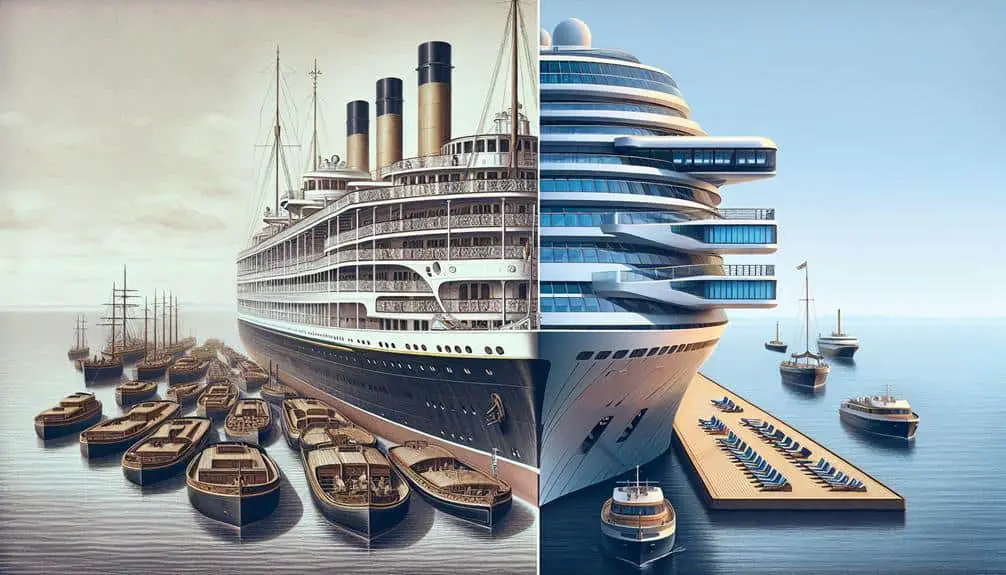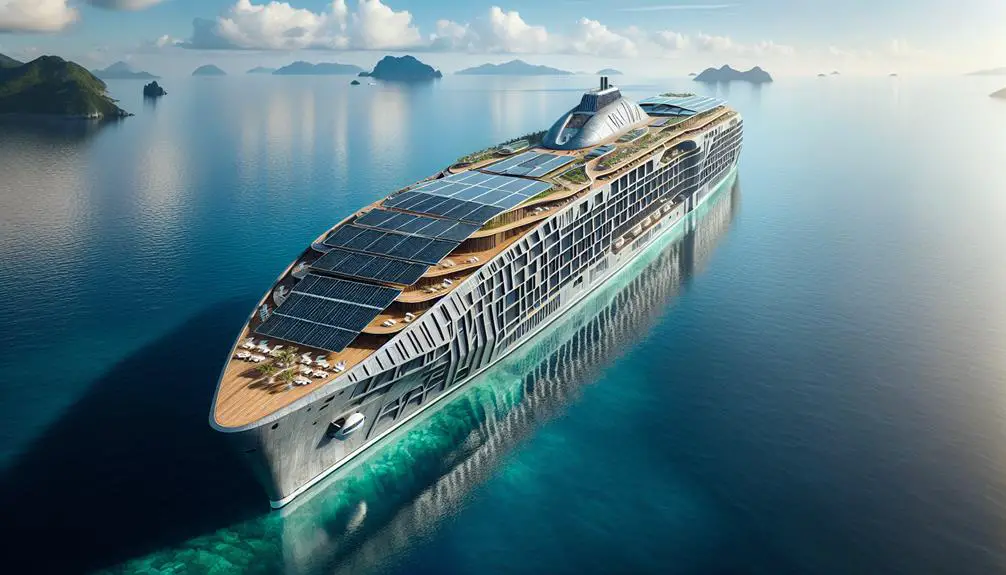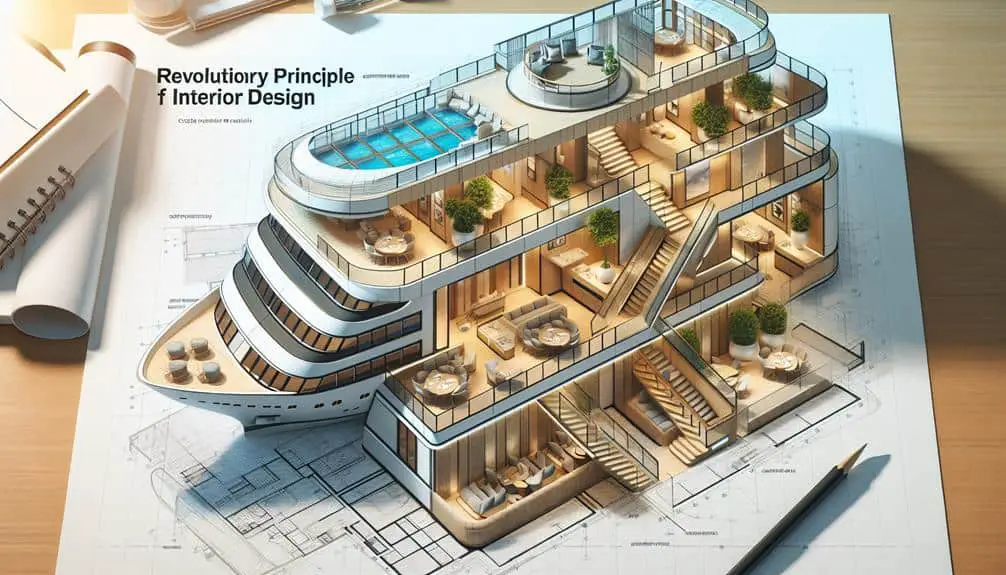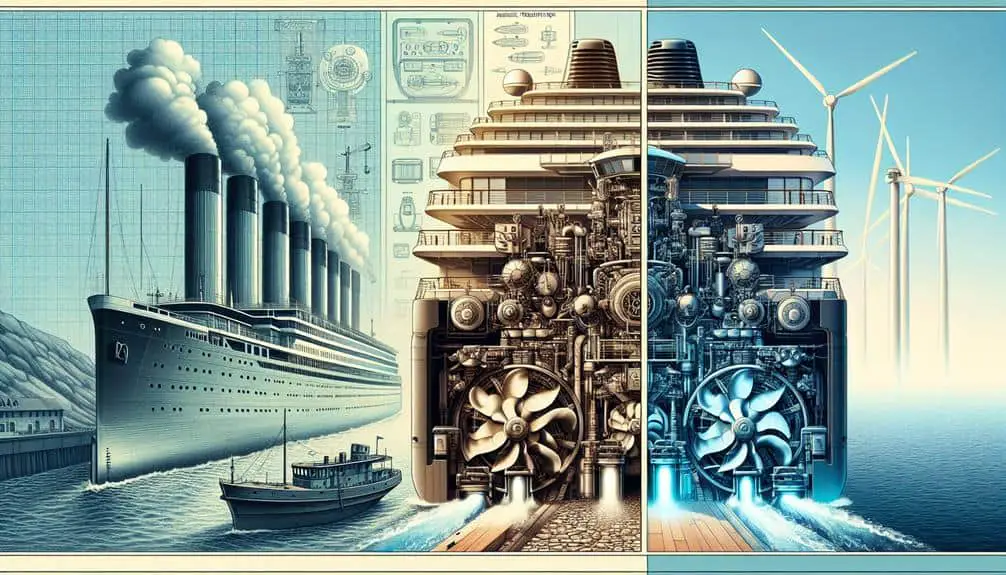Technology is crucial in traditional cruise ship design. Propulsion systems, navigation tech, and smart features like climate controls and monitoring networks are integrated for efficiency. Advanced digital tools reshape how ships are designed, promoting adaptability and innovation. Sustainable practices, such as recyclable materials and energy-efficient systems, reduce environmental impact and costs. For passengers, personalized entertainment, tailored recommendations, and seamless navigation enhance their cruise experience. Understanding these aspects offers a holistic view of how technology shapes modern cruise ships.
Key Points
- Integration of smart materials enhances ship performance.
- Virtual reality aids in detailed design optimization.
- Advanced navigation systems improve safety and efficiency.
- Automated climate control systems enhance passenger comfort.
- Smart lighting solutions increase energy efficiency.
Evolution of Cruise Ship Technology
The evolution of cruise ship technology has transformed the maritime industry, enhancing passenger comfort and safety while improving operational efficiency. Over time, innovative advancements in propulsion systems have been key to the development of modern cruise ships. Historically influenced by traditional maritime engineering, cruise ships have shifted from relying on steam engines to diesel-electric propulsion, greatly enhancing fuel efficiency and environmental sustainability.
Moreover, the integration of advanced navigation systems and stabilization technologies has played an essential role in ensuring a smooth sailing experience for passengers. Historical influences from naval architecture have led to the implementation of state-of-the-art stabilization systems, reducing the effects of rough seas and enhancing onboard comfort.
Furthermore, the incorporation of modern communication systems, such as satellite internet and advanced monitoring equipment, has enabled real-time data transmission and enhanced safety protocols. These technological advancements, influenced by historical maritime communication practices, have greatly improved emergency response capabilities and overall operational efficiency in the cruise industry.
Integration of Smart Features
Incorporating cutting-edge technology enhances the functionality and efficiency of smart features on modern cruise ships. Smart technology plays a vital role in the design integration of various systems onboard, ensuring a seamless and interconnected experience for passengers and crew alike. From automated climate control systems that adjust based on occupancy levels to smart lighting solutions that enhance energy efficiency, these features are carefully integrated into the ship's infrastructure.
Design integration of smart technology involves not only the installation of individual components but also the creation of a cohesive network that allows for centralized control and monitoring. For example, advanced sensors can collect real-time data on energy usage, allowing for proactive adjustments to optimize efficiency. Additionally, the implementation of smart navigation systems enhances safety by providing accurate positioning information and route optimization capabilities.
Digital Innovations in Ship Design
Utilizing digital advancements, ship designers are revolutionizing traditional practices to enhance efficiency and functionality in modern cruise ship design. One key area where digital innovations are making a significant impact is in the use of smart materials. These materials have the ability to adapt to changing conditions, enhancing the overall performance and sustainability of cruise ships. By incorporating smart materials into the design process, designers can create more resilient and efficient vessels that require less maintenance over time.
Virtual reality (VR) technology is also playing a pivotal role in modern ship design. Designers can now use VR tools to create and explore virtual models of cruise ships before they're physically constructed. This not only allows for a more immersive and detailed design process but also helps identify potential issues early on, saving both time and resources. Additionally, VR simulations enable designers to test different scenarios and optimize various aspects of the ship's layout for maximum efficiency and passenger comfort.
The integration of smart materials and virtual reality into ship design is pushing the boundaries of innovation in the cruise industry, leading to more advanced and sustainable vessels.
Sustainable Practices and Technology
To enhance sustainability in modern cruise ship design, integrating eco-friendly technologies and implementing green practices is essential. Incorporating sustainable materials and maximizing energy efficiency are key strategies in achieving environmentally friendly cruise ship operations. Here are three important aspects to contemplate:
- Utilization of Sustainable Materials: Opting for sustainable materials like recyclable aluminum for the ship's construction not only reduces the environmental impact but also enhances durability and longevity.
- Energy-Efficient Systems: Implementing energy-efficient technologies such as LED lighting, solar panels, and advanced propulsion systems can greatly decrease energy consumption onboard, leading to decreased emissions and operational costs.
- Waste Management Solutions: Developing effective waste management systems that include recycling facilities and advanced wastewater treatment plants can help minimize the environmental footprint of cruise ships while ensuring compliance with regulations.
Enhancing Passenger Experience
Considering the advancements in sustainable practices and technology, the focus now shifts towards optimizing passenger experience aboard modern cruise ships. To enhance passenger experience, cruise lines are increasingly incorporating personalized entertainment options to cater to diverse passenger preferences. By utilizing advanced data analytics, cruise ships can now offer tailored entertainment recommendations based on individual passenger profiles, ensuring a more engaging and enjoyable onboard experience.
In addition to personalized entertainment, vital navigation systems have become an essential aspect of enhancing the passenger experience. Modern cruise ships are equipped with cutting-edge navigation technology that allows passengers to easily navigate the ship, access real-time information about onboard activities, and even plan their daily schedules with interactive maps and notifications. This seamless integration of technology not only improves passenger convenience but also contributes to a more efficient and enjoyable cruise experience overall.
Frequently Asked Questions
How Do Cruise Ships Incorporate Technology to Enhance Safety and Security for Passengers and Crew Members?
To enhance safety and security on cruise ships, technology plays an essential role. Safety enhancements include advanced surveillance systems and emergency response tools. Crew communication is streamlined through digital platforms, ensuring efficient coordination during emergencies or routine operations.
What Are Some Challenges That Arise When Integrating New Technology Into Traditional Cruise Ship Designs?
You think integrating new tech into old cruise ship designs is smooth sailing? Think again. Challenges abound – from retrofitting spaces for innovation to ensuring seamless integration. Design meets innovation; a battle of titans.
How Does Technology Impact the Environmental Sustainability of Cruise Ships, Such as Reducing Emissions and Waste?
To enhance the environmental sustainability of cruise ships, technology plays a significant role. Innovations like advanced propulsion systems and waste management improvements reduce fuel consumption, emissions, and waste output, aligning with eco-friendly practices for a greener future.
Are There Any Regulations or Guidelines in Place to Ensure That Technology on Cruise Ships Is Used Ethically and Responsibly?
To guarantee ethical technology use on cruise ships, regulations and guidelines are essential. The International Maritime Organization (IMO) mandates strict rules like the International Safety Management (ISM) Code, promoting responsible practices and guaranteeing passenger safety.
How Do Cruise Ship Designers Balance the Use of Technology With Maintaining the Charm and Authenticity of Traditional Cruise Ship Aesthetics?
You balance innovation while preserving aesthetics in traditional cruise ship design by integrating technology thoughtfully. Utilize modern systems for efficiency without compromising the nostalgic charm. Strategic placement of equipment and design elements harmonizes the old with the new seamlessly.




